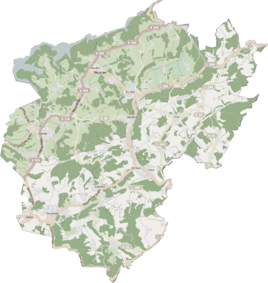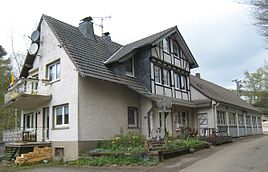Häcksbilstein
|
Häcksbilstein
Kurten municipality
Coordinates: 51 ° 3 ′ 54 ″ N , 7 ° 18 ′ 33 ″ E
|
||
|---|---|---|
| Height : | 201 m | |
| Postal code : | 51515 | |
| Area code : | 02268 | |
|
Location of Häcksbilstein in Kürten |
||
|
House in Häcksbilstein 2017
|
||
Häcksbilstein is a district in the municipality of Kürten in the Rheinisch-Bergisches Kreis .
description
The place Häcksbilstein lies in the valley of the Kürtener Sülz on a road going north from the national road 286 east of Kürten near Junkermühle . At the location, water is taken from the Kürten Sülz and fed to the Great Dhünntalsperre via the so-called Sülzüberleitung in a 3,100 meter long water tunnel .
According to the interpretation of the local history association, the word Häck indicates the proper name of a previous resident who owned property here. The syllable bil comes from piel = steep, steep. So it is a place on a steep rock. Indeed, the road goes steeply up the mountain.
history
The Topographia Ducatus Montani by Erich Philipp Ploennies from 1715, Blatt Amt Steinbach , shows that the place already existed in 1715 as a place with two courtyards and was called Bilstein . Carl Friedrich von Wiebeking names the court on his charter of the Duchy of Berg in 1789 as Bilstein . It shows that at that time Häcksbilstein was part of the Berg Honschaft in the parish of Kürten in the district court of Kürten.
Under French administration between 1806 and 1813, the Steinbach office was dissolved and Häcksbilstein was politically assigned to Mairie Olpe in the canton of Wipperfürth in the Elberfeld arrondissement . In 1816 the Prussians converted the Mairie to the Olpe mayor in the Wipperfürth district . At that time, Häcksbilstein belonged to the municipality of Olpe.
The place is recorded on the topographical survey of the Rhineland from 1824 as Billstein and on the Prussian first survey from 1840 as Häckbillstein . From the Prussian new admission in 1892, it is regularly recorded on measuring table sheets as a Häcksbilstein .
In 1822 twelve people lived in the place categorized as a courtyard and called Billstein . In 1830 the place had twelve inhabitants and was called Neu-Billstein . The town, which was categorized as a hamlet in 1845 according to the overview of the government district of Cologne , had eight houses at that time. At that time, 43 residents lived in the place called Häcks-Bilstein , 32 of them Catholic and eleven Protestant denominations . The municipal and Gutbezirksstatistik the Rhine Province leads Häcksbilstein 1871 with six houses and 39 residents. In the municipality lexicon for the Rhineland province of 1888, seven houses with 30 inhabitants are given and the place is designated. In 1895 the place had six houses and 31 residents. In 1905 the place had five houses and 20 residents and belonged denominationally to the Catholic parish of Olpe.
In 1927 the Olpe mayor's office was transferred to the Olpe office. In the Weimar Republic in 1929 the offices of Kürten were merged with the municipalities of Kürten and Bechen and Olpe with the municipalities of Olpe and Wipperfeld to form the office of Kürten. The Wipperfürth district became part of the Rheinisch-Bergisch district on October 1, 1932, with its seat in Bergisch Gladbach .
In 1975 the current municipality of Kürten was established on the basis of the Cologne Act , to which, in addition to the offices of Kürten, Bechen and Olpe, a sub-area of the city of Bensberg with Dürscheid and the surrounding areas was added.
Individual evidence
- ↑ Street names of the municipality of Kürten - origin and meaning, No. 114. Retrieved on April 19, 2017 .
- ^ Wilhelm Fabricius : Explanations for the Historical Atlas of the Rhine Province. Second volume: The map from 1789. Division and development of the territories from 1600 to 1794. Bonn 1898.
- ↑ JC Dänzer: Décret impérial sur la circonscription territoriale du grand-duché de Berg… Imperial decree on the division of the Grand Duchy of Berg . 1808, urn : nbn: de: hbz: 061: 1-84858 .
- ↑ a b History of the municipality of Kürten
- ↑ Alexander A. Mützell: New topographical-statistical-geographical dictionary of the Prussian state . tape 3 . Karl August Künnel, Halle 1822.
- ↑ Friedrich von Restorff : Topographical-statistical description of the Royal Prussian Rhine Province , Nicolai, Berlin and Stettin 1830
- ↑ Overview of the components and list of all the localities and individually named properties of the government district of Cologne: by districts, mayor's offices and parishes, with information on the number of people and the residential buildings, as well as the Confessions, Jurisdictions, Military and former state conditions. / ed. from the Royal Government of Cologne [Cologne], [1845]
- ↑ Royal Statistical Bureau Prussia (ed.): The communities and manor districts of the Prussian state and their population . The Rhine Province, No. XI . Berlin 1874.
- ↑ Königliches Statistisches Bureau (Prussia) (Ed.): Community encyclopedia for the Rhineland Province, based on the materials of the census of December 1, 1885 and other official sources, (Community encyclopedia for the Kingdom of Prussia, Volume XII), Berlin 1888.
- ↑ Königliches Statistisches Bureau (Prussia) (Ed.): Community encyclopedia for the Rhineland Province, based on the materials of the census of December 1, 1895 and other official sources, (Community encyclopedia for the Kingdom of Prussia, Volume XII), Berlin 1897.
- ↑ Royal Statistical Bureau (Prussia) (Ed.): Community encyclopedia for the Rhineland Province, based on the materials of the census of December 1, 1905 and other official sources, (Community encyclopedia for the Kingdom of Prussia, Volume XII), Berlin 1909
- ^ GV. NRW. 1974 p. 1072

